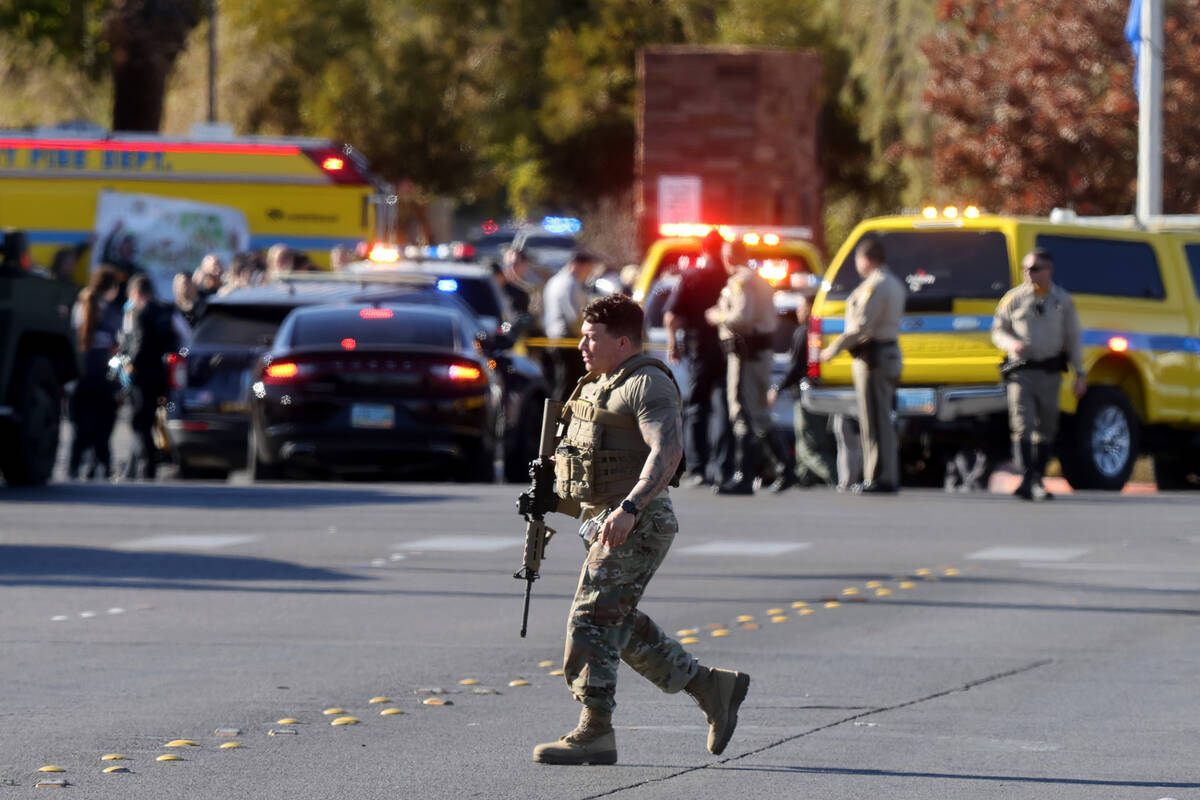
It was one of those calls that all law enforcement officers dread hearing.
On Dec. 6, a 67-year-old former college professor went to the campus of UNLV and started shooting. At the time, it was not known how many victims there were, who his targets may have been or the number of shooters. It brought back all-too-familiar memories for Las Vegas residents of Oct. 1, 2017, where a shooter killed 60 concert-goers, while wounding more than 400.
On the day of the UNLV shooting, Lt. Thomas Healing and some of his fellow Boulder City Police Department officers were at the station. That’s when Healing overheard an officer mention that there was an alert of a shooting at the university.
“I went into the communications center and asked them to call Metro to verify if our assistance was needed,” he said. “If so, we were happy to assist and bring five or six officers down. At first, we were told we were not needed but they then said, yes, please bring people down. What I thought would be three of four people (from BCPD) ended up being myself and eight others, which is almost 25% of our department.”
Healing said they all dropped everything they were doing and headed to the campus, with lights and sirens, at the same time. The Incident Command System was activated and a command post was established by the Las Vegas Metropolitan Police Department. There, people with rosters delegate assignments to the arriving officers. When Healing and his officers arrived, they were assigned to hold down the perimeter of one of the campus dorms. They were later joined by UNLV police officers and they began to clear the dorm of all of its residents.
“We went through, making sure there were no bad guys there while getting the students out safely,” he said. “It was a systematic clearing from top to bottom.”
After the dorm was cleared, the BCPD team was split into two, with half staying at the dorm, while the other half, including Healing, went back to the command post. There, they would receive varying assignments until around 6 p.m. that night.
“It was chaotic, for sure,” he said of the day until the number of shooters was determined. He also said that because of the overwhelming number of phone and texts in that area, some texts of people hiding in a room, or hearing more gunshots, were not received until hours later.
“All of that added to the chaos,” he said. “They split radio frequencies, so some units were working on one frequency and others on another. To try and manage an event like that took every resource and every bit of experience Las Vegas Metro could bring to bear, and other agencies as well.”
Healing said since the Oct. 1 shooting, a lot has been learned by law enforcement in dealing with incidents where there are active shooters and multiple casualties.
“Unquestionably, things have improved,” he said. “That was a watershed event where Las Vegas Metro really gained a lot of experience and was able to flesh a lot of things out in the theoretical trainings we do.”
In general, Healing said if BCPD hears of a major incident occurring in, or around, the Vegas Valley they will contact the lead agency to see if their assistance is needed. There are also circumstances in which other jurisdictions may be pursuing a suspect who comes within BCPD’s boundaries and in that case, assistance may be requested. Last summer, Metro was pursuing a suspect who stole a vehicle. The chase came though Boulder City and concluded beneath an underpass near Hoover Dam. BCPD assisted once the chase came into its jurisdiction.
“In those situations, we are bound by mutual aid agreements where we’ll respond, initially, and try and stabilize the scene and wait for the cavalry to arrive,” he said.
On the reverse, Boulder City has requested assistance from nearby agencies, usually involving barricaded subjects, like the recent one in a condo near Andrew Mitchell Elementary. Or requests may occur if there is a hostage situation. In that case Metro’s tactical team, including hostage negotiators, will be deployed.
“It’s a method of de-escalation,” Healing said. “We can contain and call a SWAT team because they have negotiators, armored cars and other less-lethal weapons that we don’t have. They can use different tactics and methods to get people to comply or to surrender whereas all we’d be able to do is essentially put up a perimeter.”
On those lines, Healing added, “It’s a great feeling knowing they can come and help if requested and generally they do. But it’s also kind of a scary feeling knowing it could be several minutes or even hours before you get that help. Because of that, the mantra is, ‘No one is coming, it’s up to you.’ That’s what we live by out here. Until they’re here, they’re not here. But we’re grateful we have such great working relationships with several agencies.”